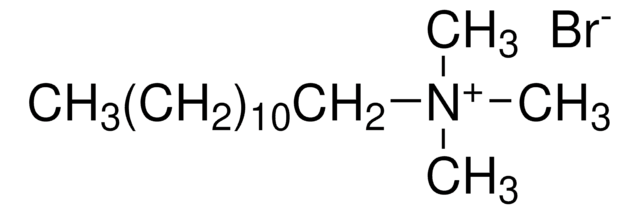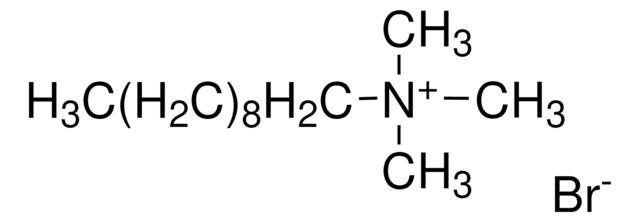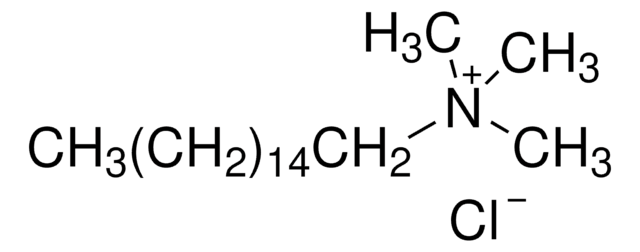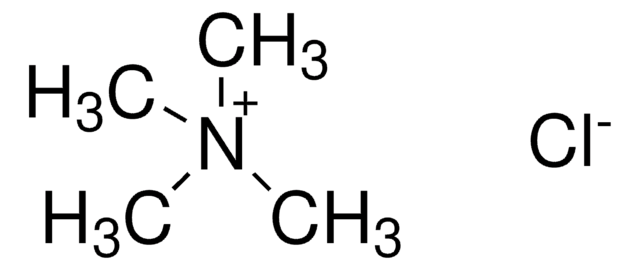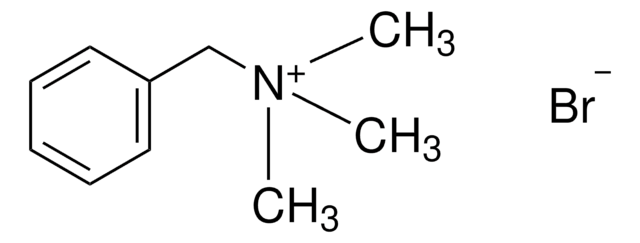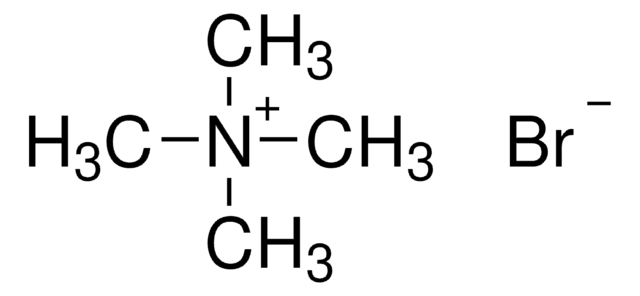53272
Hexyltrimethylammonium bromide
≥98.0% (AT)
Synonym(s):
N,N,N-Trimethylhexylammonium bromide
Sign Into View Organizational & Contract Pricing
Select a Size
All Photos(1)
Select a Size
Change View
About This Item
Linear Formula:
CH3(CH2)5N(Br)(CH3)3
CAS Number:
Molecular Weight:
224.18
Beilstein:
3913229
MDL number:
UNSPSC Code:
12352116
PubChem Substance ID:
NACRES:
NA.22
Recommended Products
Quality Level
Assay
≥98.0% (AT)
form
solid
SMILES string
[Br-].CCCCCC[N+](C)(C)C
InChI
1S/C9H22N.BrH/c1-5-6-7-8-9-10(2,3)4;/h5-9H2,1-4H3;1H/q+1;/p-1
InChI key
JYVPKRHOTGQJSE-UHFFFAOYSA-M
Related Categories
Application
Hexyltrimethylammonium bromide (HTAB) can be used as:
- A phase transfer catalyst to synthesize polyether via polycondensation of α, α′-dichloro-p-xylene with 2,2-bis(4-hydroxyphenyl)propane.
- A reagent in the preparation of ZSM-5 zeolites to tune ZSM-5 particles with a scroll-like shape and hierarchical pores.
- A surface-active agent to create the hydrophobic environment around metal nanoparticles (MNPs) even in water. This technique is highly suitable for using MNPs as electron-counting components in biosensors.
Signal Word
Warning
Hazard Statements
Precautionary Statements
Hazard Classifications
Eye Irrit. 2 - Skin Irrit. 2 - STOT SE 3
Target Organs
Respiratory system
Storage Class Code
11 - Combustible Solids
WGK
WGK 3
Flash Point(F)
Not applicable
Flash Point(C)
Not applicable
Personal Protective Equipment
dust mask type N95 (US), Eyeshields, Gloves
Choose from one of the most recent versions:
Already Own This Product?
Find documentation for the products that you have recently purchased in the Document Library.
Customers Also Viewed
A dual action of muscarinic partial agonists on pupil size of rabbit.
E Terashima et al.
Journal of pharmacobio-dynamics, 5(12), 1024-1026 (1982-12-01)
Observation of electrochemical single-electron-transfer events of gold nanoparticles in aqueous solution in the presence of both ammonium and sulfonate surface-active agents.
Misaki Nakai et al.
Angewandte Chemie (International ed. in English), 47(35), 6699-6702 (2008-07-23)
Bin Liu et al.
Proceedings of the National Academy of Sciences of the United States of America, 102(3), 589-593 (2005-01-12)
A strand-specific DNA sensory method is described based on surface-bound peptide nucleic acids and water-soluble cationic conjugated polymers. The main transduction mechanism operates by taking advantage of the net increase in negative charge at the peptide nucleic acid surface that
Eui Hyuk Jung et al.
Nature, 567(7749), 511-515 (2019-03-29)
Perovskite solar cells typically comprise electron- and hole-transport materials deposited on each side of a perovskite active layer. So far, only two organic hole-transport materials have led to state-of-the-art performance in these solar cells1: poly(triarylamine) (PTAA)2-5 and 2,2',7,7'-tetrakis(N,N-di-p-methoxyphenylamine)-9,9'-spirobifluorene (spiro-OMeTAD)6,7. However
Our team of scientists has experience in all areas of research including Life Science, Material Science, Chemical Synthesis, Chromatography, Analytical and many others.
Contact Technical Service
